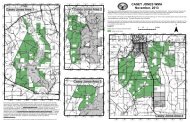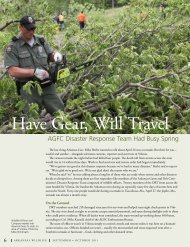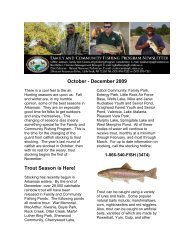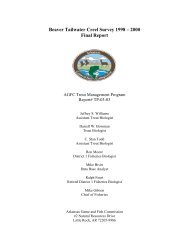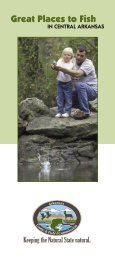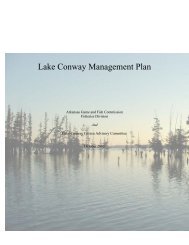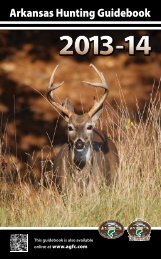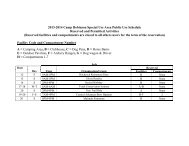2006-07 deer Report - Arkansas Game and Fish Commission
2006-07 deer Report - Arkansas Game and Fish Commission
2006-07 deer Report - Arkansas Game and Fish Commission
- No tags were found...
Create successful ePaper yourself
Turn your PDF publications into a flip-book with our unique Google optimized e-Paper software.
Section Five: Focus on Deer – Rick Evans Gr<strong>and</strong>view Prairie WMAAugust-September <strong>and</strong> December-February.Photographs were reviewed <strong>and</strong> total bucks,does, fawns <strong>and</strong> unknowns were recorded, aswell as the total point numbers on bucks. Thesurvey indicated a buck-to-doe ratio of 1:1, afawn-to-doe ratio of 1:3, <strong>and</strong> a density of one<strong>deer</strong> per 37 acres. Of the 99 photographed, 75were branch antlered with 52 of those having 8or more points. Camera surveys are still used todetect multi-pointed bucks.3. Hunter Observation – Permit hunters areasked to fill out daily observation surveys.Data has been collected from 1998-<strong>2006</strong>.Information recorded includes number ofhunters, observation hours, bucks, does, fawns,<strong>and</strong> unknowns (see Page 31). In 2004 theobservation data sheets were changed to includethe total number of points for bucks (see below).These observations provide information on <strong>deer</strong>density, buck-to-doe ratio, <strong>and</strong> fawn-to-doeratio. So far the eight years of data has foundan average density of one <strong>deer</strong> per 13 acres,an average buck-to-doe ratio of 1:1.3, <strong>and</strong> anaverage fawn-to-doe ratio of 1:3.4.4. Herd Health Analysis – The SoutheasternCooperative Wildlife Disease Study Groupperiodically conducts necropsies to determineoverall health related to the existing habitat,<strong>and</strong> any sign of disease. These investigationsrevealed normal levels of parasites <strong>and</strong> nosignificant disease risk.Late winter sampling has been conductedto monitor changes in herd conditions overtime. Using Kidney Fat Index (KFI), age,weight, numbers of fawns <strong>and</strong> breeding dates,baseline levels were established <strong>and</strong> subsequentsampling has been conducted to detect changes.Long-term values for KFI (105.91), averageweight (90.5 lbs dressed), average numberof fawns (1.92 fawn/doe), <strong>and</strong> average doeTable 2: Gr<strong>and</strong>view Prairie Hunter Observation Data 2004 - <strong>2006</strong>YearNumberofHuntersHours ofObservationSpikesBuck Total # of Points3 to45 to6Does Fawns Unknown2004 N/A 862 15 33 18 37 12 85 26 246 4722005 14 N/A 10 13 9 25 4 101 52 82 296<strong>2006</strong> 40 N/A 53 23 20 73 36 202 80 33 52<strong>07</strong> to89+Total32




